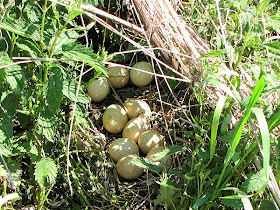Tom turkeys have big heads with no feathers on them. Usually the head is a reddish color, but if the turkey is excited, his head turns blue. His throat is also red, and he has a flappy sort of thing called a wattle on the throat and neck. The head has growths that are called caruncles, and over the beak, there is a long, fleshy snood.
If a tom turkey is ready to fight, his head turns red. Turkeys are good fighters, and they defend their territory fiercely. Toms have sharp beaks, talons, and spurs, and they know how to use these weapons. Turkeys will even attack humans if they feel threatened by them. But mostly turkeys stay undercover and blend in with the trees and stuff. They are very wary of the smallest sound or movement, and they will fly away if they think something is wrong. So for this reason it is very hard to find a turkey to shoot, if you are hunting. Which may be why most people just go to the grocery store to find one.
 |
| How is a girl to choose? |
 |
| Turkey hens |
Turkeys like to live in an open woodland or savannah, and then they fly up to perches in the trees. They fly much better than you might think, but they usually fly close to the ground, and they don't fly for more than about a quarter of a mile. Turkeys eat stuff like acorns, nuts, seeds, berries, roots, and insects. Sometimes they will also eat amphibians, lizards, and small snakes.
Turkeys are very talkative, and they say things like "gobble," "cluck," "putt," "purr," "yelp," "cackle," and "kee-kee." When toms are courting, in the spring, they do a lot of gobbling. Their gobble sound can be heard almost a mile away. They can also make a drumming sound with an air sac in their chests. The hens yelp to let the gobblers know where they are.
March and April are the months when the turkeys start their courtship. Besides gobbling and making other sexy sounds, the toms also puff out their feathers and spread their tails and drag their wings. This is called "strutting." As they get more and more excited, their heads change color from red to blue to white.
After a tom and hen have mated, the female looks for a nice place to make a nest, while the tom goes looking for another female to mate with. The nest is made in a shallow hole with lots of brush and shrubs around. There are 10 to 14 eggs, and the hen sits on them for 28 days. The baby turkeys, which are called poults, can already leave the nest in just 12 to 24 hours.
Lots of animals like to eat turkey eggs and poults, including raccoons, opossums, skunks, gray foxes, groundhogs, and snakes. The adults might get eaten by coyotes, bobcats, cougars, golden eagles, great horned owls, dogs, and red foxes. But the biggest predator of all is humans.
 |
| Where wild turkeys lived back in 1758 |
Most people have heard that Benjamin Franklin thought the turkey would be a better national bird than the bald eagle. He wrote a letter to his daughter Sarah in 1784 and said that the eagle was a bird of "bad moral character" who "does not get his Living honestly." Mr. Franklin thought this because the eagle would just perch on a dead tree and watch the fishing hawk catch a fish, and then the eagle would swoop in and steal the fish away from the hawk. Meanwhile, the turkey was "a much more respectable Bird, and withal a true original Native of America." Mr. Franklin also said that the turkey is, "though a little vain & silly, a Bird of Courage, and would not hesitate to attack a Grenadier of the British Guards who should presume to invade his Farm Yard with a red Coat on."
It is possible that Mr. Franklin was just pretending to be offended that the eagle was chosen and not the turkey. There is no record that he ever actually told Congress that he thought the turkey should be the symbol of America, so maybe he was just making a joke to amuse his daughter.
The kind of turkey that most people eat for Thanksgiving is the domestic turkey, and this turkey is white instead of brown and gray. The best guess about how the domestic turkey got started is that the Spaniards who conquered Mexico took a subspecies of turkey (which is now extinct) back to Europe, and it was inbred a whole bunch there.
Most domestic turkeys can't fly because they have been bred to have big breast muscles. They are not as smart as their wild cousins, but they are not totally stupid either.
Anyway, now that you know all about turkeys, you should go and eat your Thanksgiving dinner. Mom is going out for dinner, but I told her to be sure to bring home a big doggy bag full of turkey for us dogs!






No comments:
Post a Comment